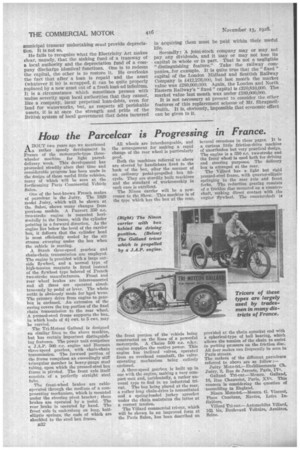How the Parcelcar is Progressing in France.
Page 16

If you've noticed an error in this article please click here to report it so we can fix it.
ABOUT two years ago we mentioned a rather speedy development in France of the motorcycle-type threewheeler machine for light parceldelivery work. This development has proceeded steadily since that time and considerable progress has been made in the desigu of these useful little vehicles, many of • which will be seen at the forthcoming Paris Commercial Vehicle Salon.
One of the best-known French makes of pareelcar is the juery. The 1029 model Juery, which will be shown at the Salon, shows many changes from previous models. A Pauvert 350 c.c. two-stroke engine is mounted horizontally in the frame, with the cylinder pointing in a forward direction. As the engine lies below the level of the carrier box, it follows that the cylinder head is most efficiently cooled by the air stream sweeping under the box when the vehicle is moving.
A Staub three-speed gearbox and chain-chain transmission are employed. The engine is provided with a large outside flywheel, and a normal type of high-tension magneto is fitted instead of the flywheel type beloved of French two-stroke manufacturers. Front and rear wheel brakes are interconnected and all three are operated simultaneously by pedal or lever. The whole outfit is obviously Made for hard wear. The primary drive from engine to gearbox is enclosed. An extension of the casing covers the top portion of the final chain transmission to the rear wheel. A pressed-steel frame supports the box,. in which loads of 4f cwt to 5 cwt. may be carried.
The Tri-Moteur Galland is designed on similar lines to the above machine, but has certain important distinguishing features. The power unit comprises a J.A.P. 500 c.c. engine and Burman three-speed gearbox, with chain-chain transmission. The forward portion of the frame comprises an exceedingly stiff triangular member in heavy-gauge steel tubing, upon which the pressed-steel box frame is pivoted. The front axle itself consists of a perfectly straight steel tube.
The front-wheel brakes are cableoperated through the medium of a compensating mechanism, which is mounted under the steering pivot bracket ; these brakes are operated by a pedal. The rear brake is operated by hand. The front axle is underslung on long, halfelliptic springs, the ends of which are shackled to the steel box frame.
)1132 All wheels are interchangeable, and the arrangement for making a rapid change of the rear wheel is particularly • -•ood • Both the machines referred to above are steered by handlebars fixed to the back of the box, after the manner of an ordinary pedal-propelled box tricycle. They are sturdily built machines and the standard of workmanship in each case is excellent.
The Ninon carrier will be a newcomer to the Show. This. machine is of the type which has the box at the rear,
the front portion of the vehicle being constructed on the lines of a powerful motorcycle. A Chaise 500 c.c. o.h.v. engine supplies the motive power. This engine has inclined valves, operated from an overhead camshaft, the valveoperating mechanism being entirely enclosed.
A three-speed gearbox is built up in one with the engine, making a very compact unit and, incidentally, a rather unusual type to find in an industrial triear. The box being placed at the rear, a rather long chain-drive is necessitated and a spring-loaded jockey sprocket under the chain maintains the latter at a correct tension.
The Villard commercial tri-car, which will he shown in an improved form at the Paris Salon, has been described on several occasions in these pages. It is a curious little friction-drive machine of unorthodox but very practical design. The engine is a 350 c.c. two-stroke and the front Wheel is used both for'driving and steering purposes. The delivery • box is arranged at the rear.
:Villard has a light but rigid pressed-steel frame, with quarter-elliptic springing to the rear axle and front forks. The reduction gearing consists of a friction disc mounted on a countershaft, making direct contact with the engine .flywheel. The countershaft is
provided at the chain sprocket end with a spherical-type of ball bearing, which allows the tension of the chain to assist in putting pressure on the friction disc. All four makes can frequently be seen in Paris streets.
The makers of the different pareelcars referred to above are as follow :— Juory Moto-tri.—Etablissements Ch. Juery, 8, Rue de airente, Paris, lye.
Galland Tri-car.—Messrs. Galland, 10, Rue Chauvelot, Paris, XVe. This concern is considering the question of assembling in England.
Ninon Moto-tri.—Messrs. G. Vincent, Place Canclaux, Nantes, Loire Inferieure.
Villard Tr-car.—Automobiles Villard, 101 his, Boulevard Voltaire, Asnieres, Seine.










































